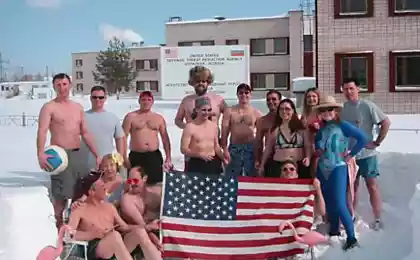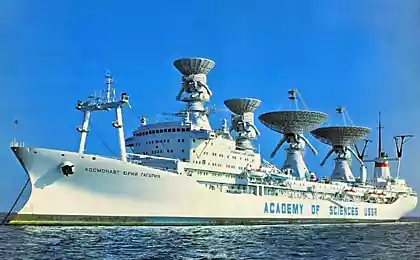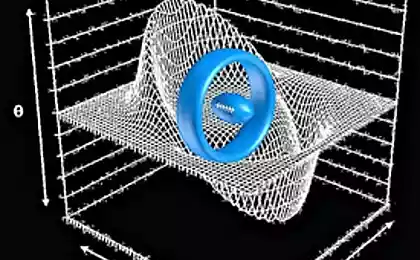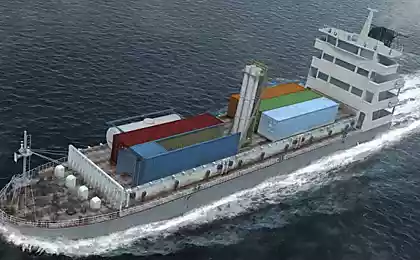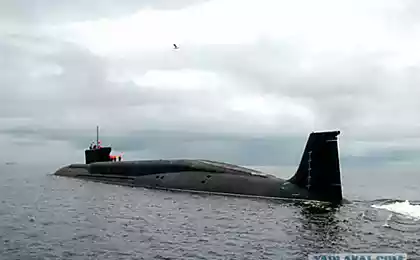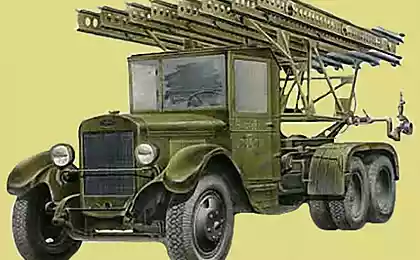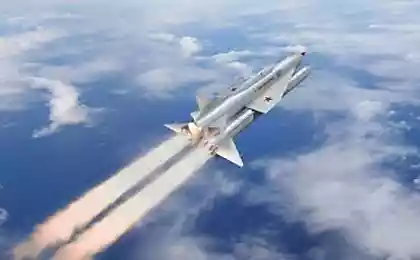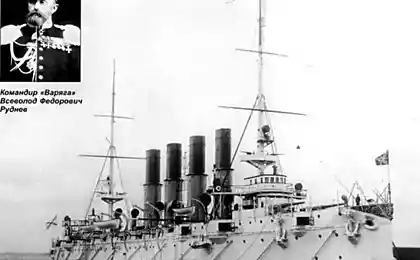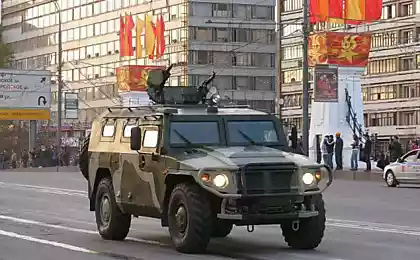1104
Ships for missiles
14 ph
Ships for missiles
When in mid-1950. warships were first guided missiles, designers are faced with a new challenge. Large, heavy and fragile units - the missiles, launchers (PU) and radar systems (RFCs) search purposes and management - firmly occupied the space above the upper deck, where they were completely open fire of the enemy, inevitable in the ocean waves and the wind, but still and takes up the center of mass, which has a negative effect on stability. And PU had, in contrast to the ground, to ensure the stabilization of missiles during rolling, the same requirement applies to the antenna post.
The first solution was obvious - lower stock of missiles under the deck, and as low as possible, and leave only the top PU. And they do pull ... However, experience has shown: this increases the cooldown PU, ie reduced rate (or unacceptably complicated setting), whereas tactics of the missiles of all classes ("ship-to-air", "ship-to-ship", "ship-to-land") requires diametrically opposite
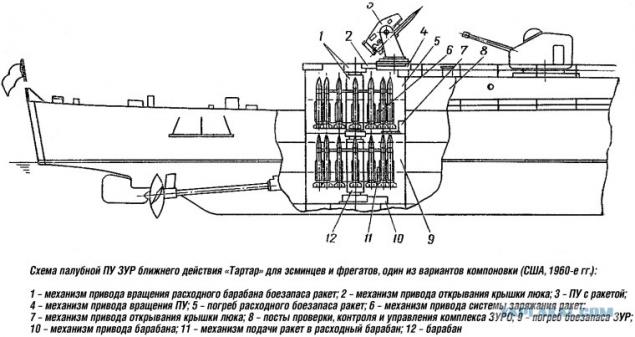
As for the radar, there was another solution, since the spread of heavy blocks and antennas practically impossible. The output of steel fixed PAR - phased antenna arrays, which complicated the drive replaced by an electronic beam steering. Antennas are integrated into the wall add-ons, but technical problems along the way was very, very much. Suffice it to say that if the first integrated PAR received the American nuclear cruiser "Long Beach" (the beginning of sea trials - 1961), the massive use of this technical solution is found only in complexes «Aegis» (historically rooted Russian transcription - "Aegis", but not "Aegis"!) on the American cruisers "Ticonderoga", the first of which entered service only in 1983. In our country RFCs "Mars-Passat" with fixed PAR received only aircraft carrying cruiser "Baku" (later "Gorshkov "Now -" Vikramaditya ") and" Tbilisi "(now the" Smith "). PAR, used in the SAM "Fort" and "Blade", as in the recent artillery SU "Puma", not integrated into the design of the superstructure and are mounted on the stabilized antenna post.
However, by this time I was also another option: do not bother with the antennas on the ship! In fact, on any vehicle height of the antennas is limited and, therefore, small and the horizon for which they are not able to look. While the horizon of the airplane, helicopter, satellite locator much further. To adjust artillery fire planes have long been used, so why not ...?
The problems here were not technical but organizational plan - interspecific integration of information flows represents a complex organizational tasks to be solved by the same US took more than half a century.
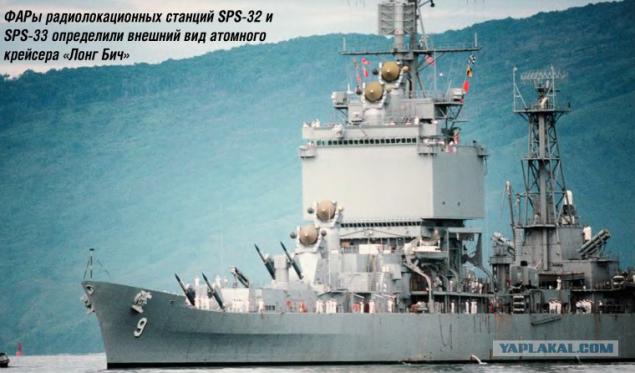
And we have ... And we have been in service with the air system targeting at strategic Tu-95RTS and deck Ka-25RTS, there is space system with satellites, "US-A" and "US-P", but they only work with specific types of cruise missiles "ship-to-ship" and other problems can not be solved! And, of course, to solve the problems of air defense, we need onboard radar complex and say to the Americans, with their aircraft carriers, they need not.
But back to the missiles. The next step was taken in our country. Already in 1959, the project "ship air defense radar long-range patrol aircraft," the developers have placed 30 long-range anti-aircraft missiles in vertical launchers (CPG), the then - on the upper deck. A year later, the same CB-MN proposed Criminal Code - "the universal multi-purpose vehicle ', which 24 missiles capable of striking both air and surface targets, have been placed in the under-deck TLU! But only in 1966 issued a decree of the Central Committee of the CPSU and the USSR on the development of long-range SAM missile vertical launch C-300F "Fort".
Tests C-300F began in 1977 on a modernized draft BOD 1134BF "Azov" and adopt "Fort" was adopted only in 1984. Then the Navy (BOD Project 1155, the last cruiser Project 1144, the same "Gorshkov" and "Smith", the TFR Project 11540) entered and short-range air defense missile system "Blade" is also equipped with CPG. In addition, under-deck (but not vertical and inclined) PU anti placed KR "Granite" at nuclear missile cruiser of the "Kirov" and the aircraft carrier "Kuznetsov". As a result, the Soviet Navy received three types of topside launchers for the three types of missiles (even four cruisers Project 1144 and 1164 PU "Fort" different) ...
Dobavleno1 in [mergetime] 1270321909 [/ mergetime]
ODD S-300F on the missile cruiser prospect. 1164 "Marshal Ustinov»
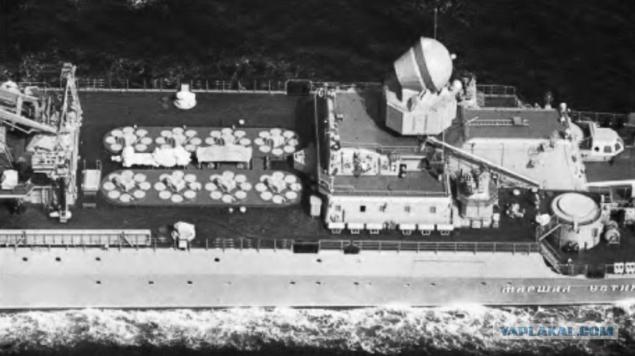
In 1987, maritime armed revolution took place: on the American cruisers "Ticonderoga" (and later - on the American destroyers "Burke Orly", Japanese and British destroyers) were universal vertical launchers (UVLM) Mk-41. They can be placed winged long-range missiles (CBRC) "ship-to-ship" and "ship-to-land" anti-missile (Plourac'h), anti-aircraft missiles small (four in each container), medium and long range, and finally - missiles capable of get and satellites in low orbits ... UVLM usually consists of seven modules vosmikonteynernyh and one with five missile containers and retractable loading manipulator. Thus, the ammunition ship, armed with two Mk-41 UVLM may consist of 122 CBRC / ZURBD / Plourac'h or 488 short-range missiles; Naturally, any combination is possible. The missiles are always ready to start, no need to move to the start-up guide. The only moving parts are the cap launchers containers and loading crane.
American ships - carriers RFCs "Aegis" and UVLM Mk-41. Left - cruiser of the "Ticonderoga" on the right - the destroyer of the "Orly Burke»
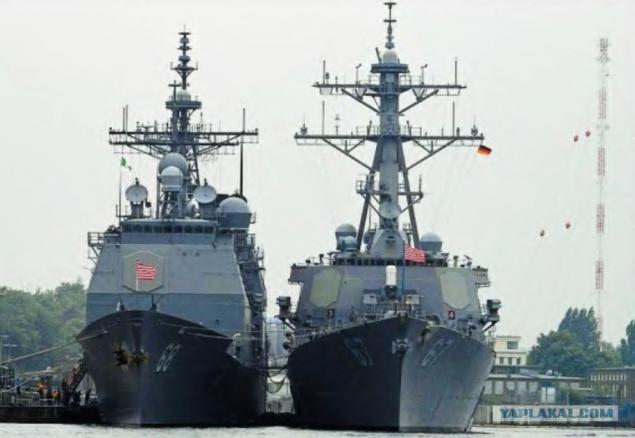
But ... the appetite, they say, comes with eating. CBRC "Tomahawk" showed their highest efficiency in actual combat. But with all that talk about their jewelry falling into the vents - and it is still a combination of chance and advertising and propaganda campaign - the military, especially the US, is well aware that a breakthrough of modern air defense subsonic (now and supersonic, but their the US does not) cruise missiles is only possible when their massive use. And for this, and the KR 122, which can take a cruiser, a little - the more so that some of the containers must be left UVLM and under anti-aircraft missiles.
There are, of course, a variant - to fit a ship-supplier, which many in the US Navy, and quickly download new ammunition. This, incidentally, simplifies the design UVLM - missile containers, vertical cells ... However (again, "but") is, firstly, not possible for any weather (in North or Barents Sea, for example, is not possible most of the year), and Secondly, linked warship and ship-supplier will be tempting target for any enemy.
And why overload? If UVLM dimensions do not exceed the size of packings, why not launch rockets directly from the supply vessels? Of course, they have to be further developed, but why not try? So in the early 1990s. the Agency promising developments DoD DARPA introduced the concept of «arsenal ship», «ship arsenal."
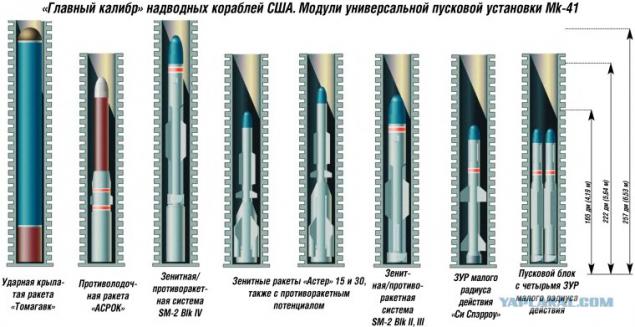
"Arsenal spike»
"Ship-arsenal" was designed to deliver massive missile attacks primarily against ground targets - in particular because of potential US adversaries are not many targets for cruise missile "ship-to-ship." Of course, the "arsenal" was to complement the carriers, especially in the conditions when the carrier aviation was impossible to use because of weather conditions, when due to the strong unsuppressed air defense it was too risky, as well as - when, for economic reasons at the forefront of it was preferable to keep not extremely expensive to operate an aircraft carrier, a submarine is not required for maintaining the combat readiness of regular flight deck aircraft.
The main efforts of designers focused on the architecture of the ship: required to provide all-weather, volley or extended in time, launch 512 cruise missiles. And besides - in every possible way to reduce the cost of construction and operation, as the price has itself exceeded the cost of conventional ammunition cruiser.
It was assumed that "ship-arsenal" is the minimum crew - no more than fifty people - will be some no, but a constructive defense - for the first time after a long break. However, what little structural protection withstand hit today (especially Soviet) anti-ship missile, so much attention was paid to reduce the visibility of - the good, and a half decades of research technology "stealth" gave some results. In order to ensure minimum vibrations "floating rocket base" in turbulent weather have been studied different hydrodynamic solutions, such as the stem, not the wave of vshodyaschego and cutting through it.
However, combat experience and elementary common sense did not allow to realize "arsenal ship" in its original form - the Americans did not dare to leave a huge warehouse of rockets absolutely no other weapons. The ship appeared helicopter universal artillery, even the MLRS system for fire support of landing, SAM defense, and in the superstructure - the RFCs for their guidance ... What did not help reduce the cost of the new ship.
Meanwhile, very cheap version of the ship under this concept in 1997, suggested the French shipbuilder Rene Valley. He pushed away from the experience of combat use of cruise missiles in the Falklands and the so-called "tanker war", which showed that modern tankers or container ships kept getting RCC (but note - this is not about heavy "Tomahawk" or, even more so, "granite" and a small "Exocet", but still ...), but modern warships - not! Loire offered to build a ship, submarine, which he called "Stryker" module tanker architecture - made of thick steel plates, with double boards and a wide mezhdubortnom space filled steel pipes of large diameter. Modules are offered in several types: fighting with UVLM management, residential, energodvigatelny, tip. Cross section - rectangular contours of the plan - the same sleek profile - in a vertical plane. Add-ins are not provided, only retractable bridge, antenna and mine air intakes, so the waves roll freely on the deck, reducing resistance and visibility both in radio and in the infrared range. R. Loire suggested that the construction of "strikers" will be so cheap that the ship could even be a one-off: in fact, the cost of construction - $ 100 mln. For the ship - "Stryker", carrying five hundred CBRC, comparable to 2-3 tactical strike aircraft! But the project of the French designer was too bold for the US Navy.
Dobavleno1 in [mergetime] 1270322290 [/ mergetime]
"Stryker" Rene Loire
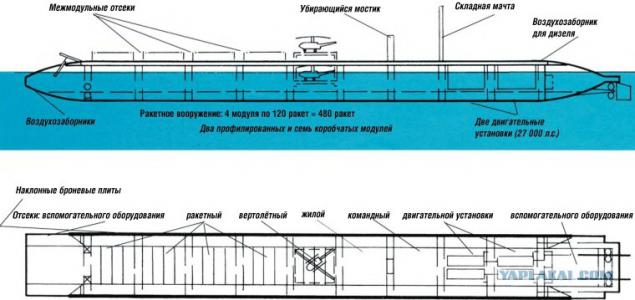
Expected complexity and different nature. Consider, for example, the possibility of "arsenal ship" for missile defense in the theater of military operations, which ships with a set of "Aegis" is already used. On the "ship-arsenal" of the respective search engines objectives and guidance is not only long-range missiles - means must act group of ships as "arsenals" and equipped with "Aegis". But the ship with the RFCs can be disabled by anti-radar missiles, for this it is not even necessarily drown. And the "arsenal ship" then becomes a combat value, turning into an ordinary floating warehouse ...
Whatever it was, in 1996-1997. have been developed and proposed five competitive projects "ship-arsenal" to which each of the five competing firms received from the Pentagon's $ 1 million. Over the next year, work continued for three selected for the first phase of the industrial group, led by firms "General Dynamics" "Lockheed Martin" and "Northrop Grumman" (they should have received already for $ 15 million.). In 1998, was supposed to pick a winner and start building prototype ship tests that were planned for 2000. However, in late 1997, the program of creation "arsenal ship", which is estimated at approximately 520 million USD., Was closed.
The main reason should be considered in the analysis to identify the competitive projects nonuniversality not even the ship itself, and all of the proposed weapons systems, including the ship available or being developed rockets and external systems as the targeting and the operation. In fact, there was no way CBRC guidance on moving ground targets (and even now it is still being developed); under development are combat units (non-nuclear, natural) CBRC dlyaporazheniya tank columns. There was the "arsenal" of means of self-defense against the threat from the water - both from submarines and mine. Finally, certain claims caused and the "heart" of the project - UVLM: rocket explosion in the container or at the start is unlikely, but not excluded, and in the latter case of failure can leave the entire module, and then the whole launcher ... In short, concluded that this ship of the US Navy is not needed. But some new need!
"Arsenal" should not act in a vacuum but in a complex with other ships - aircraft carriers and various escorts. Here are the latest and began to reform. In 1997, "arsenal" combined with a program of creating air defense ship CS-21 ... next-generation destroyer. Until November 2001 the program was called DD-21, then - DD (X), and in 2006 was named head DDG-1000.
The missile destroyer of the XXI century
The name of the class of ships "Battlestar" has existed since the middle of the XIX century, and the "Destroyer" - since the beginning of XX. Before the 1970s. distinction ships of these classes had some value, although more and less. In the end, the Soviet missile destroyers of the project began 58 missile cruiser at the end of 1950, and Project 956 destroyers 1970 size, tonnage and firepower are consistent light cruisers World War II. US destroyers like "Orly Burke" differ from cruisers "Ticonderoga" only that are not 122, and 90 missiles in UVLM or two, and one 127-mm gun, and the Japanese "destroyers" - is virtually aircraft carriers!
Therefore, let the traditional American classification is not cheating - more correct to speak of a "multi-purpose escort ships' ability to fight surface, underwater, air and ground enemy, to protect against the threat from the sky and from the water carriers and amphibious transports.
... In one of the books on the history of the Russian Navy the head of the nuclear missile cruiser of the "Kirov" named "Full rampant." And it is justified, because the ships, originally conceived as a guard (!), Eventually became heavy cruisers, carrying all kinds of weapons of the ship, except for intercontinental ballistic missiles and mine-clearing.
But then what to say about the American "destroyers» DDG-1000? Judge for yourself.
The main weapon of the new ships should be UVLM Mk-57 of 20 blocks of 4 cells each. The cell can be CBRC "Tomahawk" missiles the SM-3 (the ability to "get" a head of an ICBM or a satellite in low orbit!), 4 short-range missiles ESSM (based on the Jets' Sparrow "). There should be more anti-missile ASROC, but information on their application in the DDG-1000 in different sources differ.
However, the most interesting thing in the Mk-57 - its placement. If blocks Mk-41stavili compartments in the center plane of the ship, the modules are placed in a new UVLM bead - 6 at the bow, and 4 - the stern. To create PVPU - peripheral CPG - developers inspired the desire to eliminate disabling the entire system from a single abnormal blasting missiles. From the interior vehicle compartments separated PVPU 12-mm steel sheet, and outside reserved 14mm casing (the bottom part, almost at the waterline also 12 mm). PVPU It was one of the reasons that the competition of projects won by the sentence "Northrop Grumman": a competitor ("General Dynamics") placing the CPG was traditional. In addition, primarily for ground attack, the destroyer is armed with two new artillery units AGS (from the English. 'Perspective artillery system "). Each of the 155-mm guns should send 12 rounds per minute at a distance of 100 miles, with to improve the accuracy to be used even shells with satellite navigation. Ammunition - 600 155 mm rounds. For self-defense - two 57-mm naval gun Mk-110 (220 rds / min, 9 miles).
The diagram in front of and behind the superstructure gray marked located pobortno PVPU

To manage all this magnificence used radar system with headlights integrated into the walls of the superstructure. An important innovation is the work of the RFCs simultaneously in two ranges - X and S (initially supposed to - L), which increases the number of tracked objects, as well as the accuracy of determining their origin.
Source:
Ships for missiles
When in mid-1950. warships were first guided missiles, designers are faced with a new challenge. Large, heavy and fragile units - the missiles, launchers (PU) and radar systems (RFCs) search purposes and management - firmly occupied the space above the upper deck, where they were completely open fire of the enemy, inevitable in the ocean waves and the wind, but still and takes up the center of mass, which has a negative effect on stability. And PU had, in contrast to the ground, to ensure the stabilization of missiles during rolling, the same requirement applies to the antenna post.
The first solution was obvious - lower stock of missiles under the deck, and as low as possible, and leave only the top PU. And they do pull ... However, experience has shown: this increases the cooldown PU, ie reduced rate (or unacceptably complicated setting), whereas tactics of the missiles of all classes ("ship-to-air", "ship-to-ship", "ship-to-land") requires diametrically opposite

As for the radar, there was another solution, since the spread of heavy blocks and antennas practically impossible. The output of steel fixed PAR - phased antenna arrays, which complicated the drive replaced by an electronic beam steering. Antennas are integrated into the wall add-ons, but technical problems along the way was very, very much. Suffice it to say that if the first integrated PAR received the American nuclear cruiser "Long Beach" (the beginning of sea trials - 1961), the massive use of this technical solution is found only in complexes «Aegis» (historically rooted Russian transcription - "Aegis", but not "Aegis"!) on the American cruisers "Ticonderoga", the first of which entered service only in 1983. In our country RFCs "Mars-Passat" with fixed PAR received only aircraft carrying cruiser "Baku" (later "Gorshkov "Now -" Vikramaditya ") and" Tbilisi "(now the" Smith "). PAR, used in the SAM "Fort" and "Blade", as in the recent artillery SU "Puma", not integrated into the design of the superstructure and are mounted on the stabilized antenna post.
However, by this time I was also another option: do not bother with the antennas on the ship! In fact, on any vehicle height of the antennas is limited and, therefore, small and the horizon for which they are not able to look. While the horizon of the airplane, helicopter, satellite locator much further. To adjust artillery fire planes have long been used, so why not ...?
The problems here were not technical but organizational plan - interspecific integration of information flows represents a complex organizational tasks to be solved by the same US took more than half a century.

And we have ... And we have been in service with the air system targeting at strategic Tu-95RTS and deck Ka-25RTS, there is space system with satellites, "US-A" and "US-P", but they only work with specific types of cruise missiles "ship-to-ship" and other problems can not be solved! And, of course, to solve the problems of air defense, we need onboard radar complex and say to the Americans, with their aircraft carriers, they need not.
But back to the missiles. The next step was taken in our country. Already in 1959, the project "ship air defense radar long-range patrol aircraft," the developers have placed 30 long-range anti-aircraft missiles in vertical launchers (CPG), the then - on the upper deck. A year later, the same CB-MN proposed Criminal Code - "the universal multi-purpose vehicle ', which 24 missiles capable of striking both air and surface targets, have been placed in the under-deck TLU! But only in 1966 issued a decree of the Central Committee of the CPSU and the USSR on the development of long-range SAM missile vertical launch C-300F "Fort".
Tests C-300F began in 1977 on a modernized draft BOD 1134BF "Azov" and adopt "Fort" was adopted only in 1984. Then the Navy (BOD Project 1155, the last cruiser Project 1144, the same "Gorshkov" and "Smith", the TFR Project 11540) entered and short-range air defense missile system "Blade" is also equipped with CPG. In addition, under-deck (but not vertical and inclined) PU anti placed KR "Granite" at nuclear missile cruiser of the "Kirov" and the aircraft carrier "Kuznetsov". As a result, the Soviet Navy received three types of topside launchers for the three types of missiles (even four cruisers Project 1144 and 1164 PU "Fort" different) ...
Dobavleno1 in [mergetime] 1270321909 [/ mergetime]
ODD S-300F on the missile cruiser prospect. 1164 "Marshal Ustinov»

In 1987, maritime armed revolution took place: on the American cruisers "Ticonderoga" (and later - on the American destroyers "Burke Orly", Japanese and British destroyers) were universal vertical launchers (UVLM) Mk-41. They can be placed winged long-range missiles (CBRC) "ship-to-ship" and "ship-to-land" anti-missile (Plourac'h), anti-aircraft missiles small (four in each container), medium and long range, and finally - missiles capable of get and satellites in low orbits ... UVLM usually consists of seven modules vosmikonteynernyh and one with five missile containers and retractable loading manipulator. Thus, the ammunition ship, armed with two Mk-41 UVLM may consist of 122 CBRC / ZURBD / Plourac'h or 488 short-range missiles; Naturally, any combination is possible. The missiles are always ready to start, no need to move to the start-up guide. The only moving parts are the cap launchers containers and loading crane.
American ships - carriers RFCs "Aegis" and UVLM Mk-41. Left - cruiser of the "Ticonderoga" on the right - the destroyer of the "Orly Burke»

But ... the appetite, they say, comes with eating. CBRC "Tomahawk" showed their highest efficiency in actual combat. But with all that talk about their jewelry falling into the vents - and it is still a combination of chance and advertising and propaganda campaign - the military, especially the US, is well aware that a breakthrough of modern air defense subsonic (now and supersonic, but their the US does not) cruise missiles is only possible when their massive use. And for this, and the KR 122, which can take a cruiser, a little - the more so that some of the containers must be left UVLM and under anti-aircraft missiles.
There are, of course, a variant - to fit a ship-supplier, which many in the US Navy, and quickly download new ammunition. This, incidentally, simplifies the design UVLM - missile containers, vertical cells ... However (again, "but") is, firstly, not possible for any weather (in North or Barents Sea, for example, is not possible most of the year), and Secondly, linked warship and ship-supplier will be tempting target for any enemy.
And why overload? If UVLM dimensions do not exceed the size of packings, why not launch rockets directly from the supply vessels? Of course, they have to be further developed, but why not try? So in the early 1990s. the Agency promising developments DoD DARPA introduced the concept of «arsenal ship», «ship arsenal."

"Arsenal spike»
"Ship-arsenal" was designed to deliver massive missile attacks primarily against ground targets - in particular because of potential US adversaries are not many targets for cruise missile "ship-to-ship." Of course, the "arsenal" was to complement the carriers, especially in the conditions when the carrier aviation was impossible to use because of weather conditions, when due to the strong unsuppressed air defense it was too risky, as well as - when, for economic reasons at the forefront of it was preferable to keep not extremely expensive to operate an aircraft carrier, a submarine is not required for maintaining the combat readiness of regular flight deck aircraft.
The main efforts of designers focused on the architecture of the ship: required to provide all-weather, volley or extended in time, launch 512 cruise missiles. And besides - in every possible way to reduce the cost of construction and operation, as the price has itself exceeded the cost of conventional ammunition cruiser.
It was assumed that "ship-arsenal" is the minimum crew - no more than fifty people - will be some no, but a constructive defense - for the first time after a long break. However, what little structural protection withstand hit today (especially Soviet) anti-ship missile, so much attention was paid to reduce the visibility of - the good, and a half decades of research technology "stealth" gave some results. In order to ensure minimum vibrations "floating rocket base" in turbulent weather have been studied different hydrodynamic solutions, such as the stem, not the wave of vshodyaschego and cutting through it.
However, combat experience and elementary common sense did not allow to realize "arsenal ship" in its original form - the Americans did not dare to leave a huge warehouse of rockets absolutely no other weapons. The ship appeared helicopter universal artillery, even the MLRS system for fire support of landing, SAM defense, and in the superstructure - the RFCs for their guidance ... What did not help reduce the cost of the new ship.
Meanwhile, very cheap version of the ship under this concept in 1997, suggested the French shipbuilder Rene Valley. He pushed away from the experience of combat use of cruise missiles in the Falklands and the so-called "tanker war", which showed that modern tankers or container ships kept getting RCC (but note - this is not about heavy "Tomahawk" or, even more so, "granite" and a small "Exocet", but still ...), but modern warships - not! Loire offered to build a ship, submarine, which he called "Stryker" module tanker architecture - made of thick steel plates, with double boards and a wide mezhdubortnom space filled steel pipes of large diameter. Modules are offered in several types: fighting with UVLM management, residential, energodvigatelny, tip. Cross section - rectangular contours of the plan - the same sleek profile - in a vertical plane. Add-ins are not provided, only retractable bridge, antenna and mine air intakes, so the waves roll freely on the deck, reducing resistance and visibility both in radio and in the infrared range. R. Loire suggested that the construction of "strikers" will be so cheap that the ship could even be a one-off: in fact, the cost of construction - $ 100 mln. For the ship - "Stryker", carrying five hundred CBRC, comparable to 2-3 tactical strike aircraft! But the project of the French designer was too bold for the US Navy.
Dobavleno1 in [mergetime] 1270322290 [/ mergetime]
"Stryker" Rene Loire

Expected complexity and different nature. Consider, for example, the possibility of "arsenal ship" for missile defense in the theater of military operations, which ships with a set of "Aegis" is already used. On the "ship-arsenal" of the respective search engines objectives and guidance is not only long-range missiles - means must act group of ships as "arsenals" and equipped with "Aegis". But the ship with the RFCs can be disabled by anti-radar missiles, for this it is not even necessarily drown. And the "arsenal ship" then becomes a combat value, turning into an ordinary floating warehouse ...
Whatever it was, in 1996-1997. have been developed and proposed five competitive projects "ship-arsenal" to which each of the five competing firms received from the Pentagon's $ 1 million. Over the next year, work continued for three selected for the first phase of the industrial group, led by firms "General Dynamics" "Lockheed Martin" and "Northrop Grumman" (they should have received already for $ 15 million.). In 1998, was supposed to pick a winner and start building prototype ship tests that were planned for 2000. However, in late 1997, the program of creation "arsenal ship", which is estimated at approximately 520 million USD., Was closed.
The main reason should be considered in the analysis to identify the competitive projects nonuniversality not even the ship itself, and all of the proposed weapons systems, including the ship available or being developed rockets and external systems as the targeting and the operation. In fact, there was no way CBRC guidance on moving ground targets (and even now it is still being developed); under development are combat units (non-nuclear, natural) CBRC dlyaporazheniya tank columns. There was the "arsenal" of means of self-defense against the threat from the water - both from submarines and mine. Finally, certain claims caused and the "heart" of the project - UVLM: rocket explosion in the container or at the start is unlikely, but not excluded, and in the latter case of failure can leave the entire module, and then the whole launcher ... In short, concluded that this ship of the US Navy is not needed. But some new need!
"Arsenal" should not act in a vacuum but in a complex with other ships - aircraft carriers and various escorts. Here are the latest and began to reform. In 1997, "arsenal" combined with a program of creating air defense ship CS-21 ... next-generation destroyer. Until November 2001 the program was called DD-21, then - DD (X), and in 2006 was named head DDG-1000.
The missile destroyer of the XXI century
The name of the class of ships "Battlestar" has existed since the middle of the XIX century, and the "Destroyer" - since the beginning of XX. Before the 1970s. distinction ships of these classes had some value, although more and less. In the end, the Soviet missile destroyers of the project began 58 missile cruiser at the end of 1950, and Project 956 destroyers 1970 size, tonnage and firepower are consistent light cruisers World War II. US destroyers like "Orly Burke" differ from cruisers "Ticonderoga" only that are not 122, and 90 missiles in UVLM or two, and one 127-mm gun, and the Japanese "destroyers" - is virtually aircraft carriers!
Therefore, let the traditional American classification is not cheating - more correct to speak of a "multi-purpose escort ships' ability to fight surface, underwater, air and ground enemy, to protect against the threat from the sky and from the water carriers and amphibious transports.
... In one of the books on the history of the Russian Navy the head of the nuclear missile cruiser of the "Kirov" named "Full rampant." And it is justified, because the ships, originally conceived as a guard (!), Eventually became heavy cruisers, carrying all kinds of weapons of the ship, except for intercontinental ballistic missiles and mine-clearing.
But then what to say about the American "destroyers» DDG-1000? Judge for yourself.
The main weapon of the new ships should be UVLM Mk-57 of 20 blocks of 4 cells each. The cell can be CBRC "Tomahawk" missiles the SM-3 (the ability to "get" a head of an ICBM or a satellite in low orbit!), 4 short-range missiles ESSM (based on the Jets' Sparrow "). There should be more anti-missile ASROC, but information on their application in the DDG-1000 in different sources differ.
However, the most interesting thing in the Mk-57 - its placement. If blocks Mk-41stavili compartments in the center plane of the ship, the modules are placed in a new UVLM bead - 6 at the bow, and 4 - the stern. To create PVPU - peripheral CPG - developers inspired the desire to eliminate disabling the entire system from a single abnormal blasting missiles. From the interior vehicle compartments separated PVPU 12-mm steel sheet, and outside reserved 14mm casing (the bottom part, almost at the waterline also 12 mm). PVPU It was one of the reasons that the competition of projects won by the sentence "Northrop Grumman": a competitor ("General Dynamics") placing the CPG was traditional. In addition, primarily for ground attack, the destroyer is armed with two new artillery units AGS (from the English. 'Perspective artillery system "). Each of the 155-mm guns should send 12 rounds per minute at a distance of 100 miles, with to improve the accuracy to be used even shells with satellite navigation. Ammunition - 600 155 mm rounds. For self-defense - two 57-mm naval gun Mk-110 (220 rds / min, 9 miles).
The diagram in front of and behind the superstructure gray marked located pobortno PVPU

To manage all this magnificence used radar system with headlights integrated into the walls of the superstructure. An important innovation is the work of the RFCs simultaneously in two ranges - X and S (initially supposed to - L), which increases the number of tracked objects, as well as the accuracy of determining their origin.
Source:


